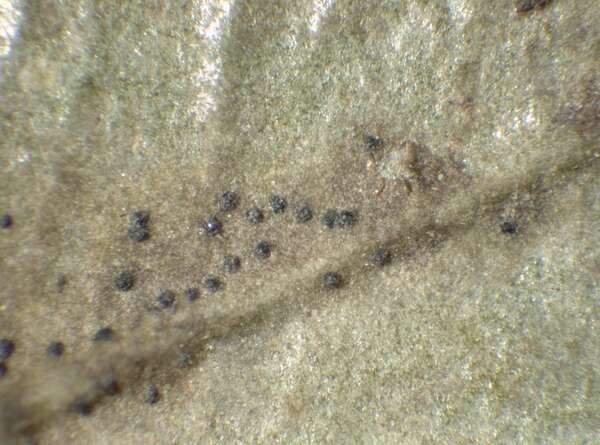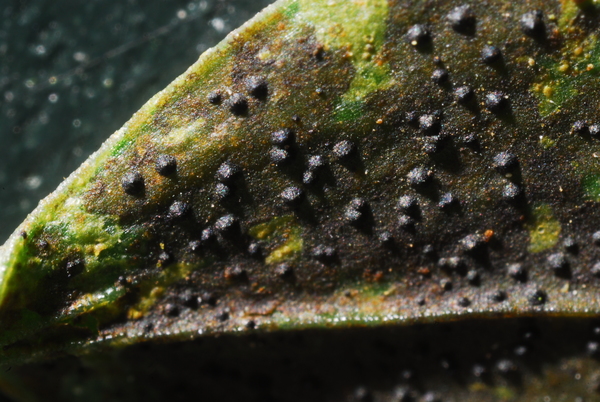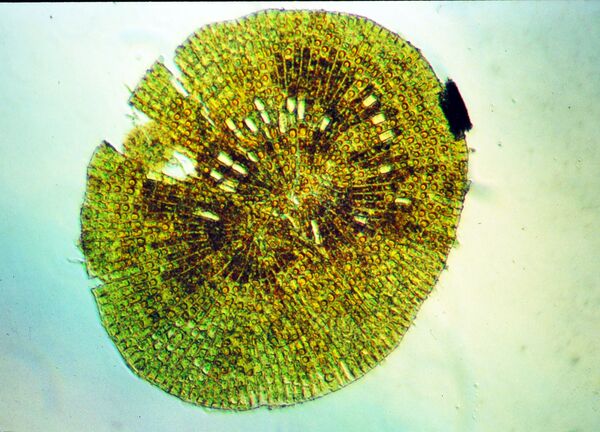Dichoporis minor (Vězda) Cl. Roux
Bull. Soc. linn. Provence, 74: 124, 2023.. Basionym: Raciborskiella minor Vězda - Folia Geobot. Phytotaxon., 18: 49, 1983.
Synonyms: Strigula minor (Vězda) Cl. Roux & Sérus.
Distribution: S - Camp (Puntillo & al. 2000, Puntillo 2000, Nimis & Tretiach 2004), Cal (Puntillo 2000, Roux & Sérusiaux 2004).
Description: Thallus crustose, epicuticular on evergreen leaves, very thin, dark brown to almost black, membranous. Perithecia 0.15-0.3 mm across, black to brown-black, subglobose, forming distinct projections. Involucrellum carbonaceous black, reaching the base of the perithecium but not surrounding it; exciple at first colourless, then blackish, mostly fused with the involucrellum; hamathecium of 1.5-2 µm thick, mostly simple paraphysoids. Asci 8-spored, clavate, bitunicate-fissitunicate, shortly stalked at base, the apex thickened into a tholus, with a narrow ocular chamber, I-. Ascospores 1-septate, strongly constricted at septum and tending to break down into part-spores, hyaline, fusiform, (15.5-)17-23(-24) x 2.5-4 µm. Pycnidia often of two types. Macropycnidia subglobose, with a carbonaceous involucrellum, 0.1-0.3 mm across; macroconidia subapically inserted on the conidiogenous cell, 1-septate, 9-14 x 1.5-4.5 µm, with 2.5-6 µm long mucous appendages. Micropycnidia 0.05-0.1 mm across; microconidia fusiform or subfusiform, 2.5-4 x 1-1.5 µm. Photobiont trentepohlioid (Phycopeltis). Spot tests: thallus K-, C-, KC-, P-. Chemistry: thallus without lichen substances. Note: a mild-temperate to Mediterranean-Atlantic species with subtropical affinities, described from Georgia and also known from the Pyrenees. In Italy it was found on evergreen leaves, and on cladodes of Ruscus in warm-humid stands of the South. It is included in the Italian red list of epiphytic lichens as “Endangered” (Nascimbene & al. 2013c).
Growth form: Crustose
Substrata: bark and leaves
Photobiont: green algae other than Trentepohlia
Reproductive strategy: mainly sexual
Restricted to humid-warm, oceanic areas
Commonnes-rarity: (info)
Alpine belt: absent
Subalpine belt: absent
Oromediterranean belt: absent
Montane belt: absent
Submediterranean belt: absent
Padanian area: absent
Humid submediterranean belt: extremely rare
Humid mediterranean belt: extremely rare
Dry mediterranean belt: absent

Predictive model
Herbarium samples
Growth form: Crustose
Substrata: bark and leaves
Photobiont: green algae other than Trentepohlia
Reproductive strategy: mainly sexual
Restricted to humid-warm, oceanic areas
Commonnes-rarity: (info)
Alpine belt: absent
Subalpine belt: absent
Oromediterranean belt: absent
Montane belt: absent
Submediterranean belt: absent
Padanian area: absent
Humid submediterranean belt: extremely rare
Humid mediterranean belt: extremely rare
Dry mediterranean belt: absent

Predictive model
| Herbarium samples |







